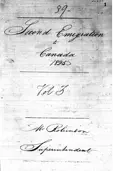Peter Robinson Settlement
2025 is the 200th anniversary of the Peter Robinson settlement in Kawartha Lakes and the surrounding region which saw over 2,000 poor Irish immigrants from Kerry, Cork, Tipperary and Limerick brought to Ontario through a planned settlement scheme orchestrated by Canadian politician and administrator Peter Robinson. Local residents, many of whom are descended from these early settlers, are commemorating this important anniversary throughout 2025.

The immigration scheme that is now known as the Peter Robinson Settlement, was conceived in the early 1820s by Under Secretary for Colonial Affairs Robert J. Wilmot-Horton to bring impoverished Irish farmers to Upper Canada (Ontario) where they would be settled in newly surveyed townships in the back lakes and provided with provisions to clear the land for agriculture. The first such scheme was undertaken in 1823 where around 500 people from the Blackwater River valley region of County Cork were settled in the Ottawa Valley.
Two years later, Robinson initiated a much larger scheme to bring immigrants into the recently surveyed townships in the Newcastle District which included that townships that eventually became of the City of Kawartha Lakes. In May 1825, nine ships carrying over 2,000 people from just over 400 families who arrived in Peterborough, then known as Scott's Plains, in early fall 1825. These families were sponsored by local clergy and gentlemen to allow them to join the scheme. The vast majority of families were granted land in just seven townships: Emily, Gore of Emily (Ennismore), Otonabee, Douro, Asphodel, Smith and Ops. Most of the settlers were Catholics and came in large family groupings with children ranging from infants to young adults. The majority had been farmers although some tradesmen were also included in the settlement scheme.
We the undersigned Clergymen and Magistrates hereby certify that the above named persons who have been selected by Mr. Robinson from the neighbourhood and Michelstown and from the borders of the counties of Cork, Limerick and Tipperary, are person totally unable to pay for their own passage to America and come within the description of persons deemed fit subjects for emigration to Canada, being persons without employment and generally bred to agriculture, and who have been lately dispossessed of their lands...We also beg to add that our best thanks are justly due to Mr. Robinson for his unremitting attention to the selection of proper persons for emigration and his willingness at all times to attend the suggestions of the Gentlemen in the neighbourhood.

Over half of the families were granted land in Emily Township. Emily was first surveyed for settlement in 1818 with the signing of the Rice Lake Treaty which ceded nearly 2 million acres of Indigenous land for European settlement throughout what is now the City of Kawartha Lakes and Peterborough County. Some early clearing occurred in 1819 and 1820, but the first settlers arrived in the southern part of the township in 1821. These early settlers were primarily Irish and English Protestants and settled on the first six concessions of the township.
When the Robinson Settlers arrived in Canada and were assigned their land grants, the central and northern concessions in Emily were largely unsettled by Europeans. Land grants in this area were handed out to settlers in October and November 1825; just over 13,800 acres of land in Emily, in approximately 100 acres parcels were granted to the heads of 142 families, usually the husband and father, and to boys age 18 and over. Families were also given set rations for the next eighteen months, including salt pork and flour, as well as seed potatoes, seed corn, and agricultural implements.
Over the next several decades, the families who settled in Emily continued to clear the land and establish their farms. Over the years, local business were also established, such as blacksmith shops and general stores, to serve the farming families who were now firming ensconced in the landscape. Soon a small hamlet sprang up at the cross roads known as Downey's Cross, after the Downey family whose land grant was nearby. A school had been established at this spot alongside several businesses including a hotel. In 1857, land was purchased from Bartholomew Downey and a frame church was built there for the large Catholic population; this church would become St. Luke's Catholic Church and the brick cladding, chancel, vestry and bell tower were added in 1886.
Although many of the settlers and their children left Emily Township to live elsewhere in Kawartha Lakes, in other parts of Ontario, in different provinces and even in the United States, many stayed in Emily with some remaining on their original homesteads. Downeyville and St. Luke's Church remain important landmarks in Emily Township that remind us of the township's history and settlement of the area over 200 years.
Peter Robinson Land Grants
Use our interactive mapping tool explore and learn more about the land grants given to the Peter Robinson settlers in 1825 which are primarily located in Emily Township. This searchable resource provides information on the grants given to each family as well as information on family members.
Use the search bar to search a last name, origin community or county or ship name. This map can be toggled to full screen using the icon on the bottom right hand corner of the map.
Contact Us
Kawartha Lakes
P.O. Box 9000, 26 Francis Street
Lindsay, ON, K9V 5R8
Telephone: 705-324-9411
Toll free at 1-888-822-2225
After-hours emergencies: 1-877-885-7337








